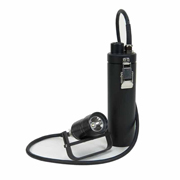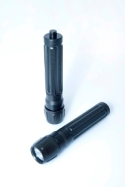Evolution of Dive Lights
Primary lights
Before going into details, we would first need to separate the primary dive light and the back-up lights aka BULs. The primary needs to have a stronger output that the back up light and needs to have a burn time of the planned total dive, plus reserve. We could say, time and a half to be conservative. On the other hand the BULs, have to offer, combined burn time of twice the total dive time as they’ll be used to exit the cave/overhead environment in the even of a primary light failure. They have to be bright enough not to delay the exit too much.Thanks to technology and companies working to keep their customers satisfied, we now have an array of choice for primary and back ups. In house lighting has evolved as well and thanks to this evolution. To let you know, if you didn’t already knew, the primary light used int he early Sheck Exley days, were of tungsten filament with a ‘yellow’ colour all this connected to a motorcycle baterry…Talk about history! I’m glad we are where we are now with light technology.
When diving in caves you need the brightest light possible, specially if you are exploring a new cave or diving a cave you never dived before. It helps building an ‘image’ of the cave, better than with low-wattage yellowish lights!! So the solution was then, to pimp up (can I say that?) the wattage getting to the bulb and override the bulb to get a brighter spectrum. The downside really was that by doing so, the bulb failures were common and it was practice to carry two or three even four primary light during long cave dives.
Then the bulb technology kind of helped a bit and brought us the gas-filled bulbs that were higher in color temperature, accepting higher voltage better and mass-produced so cheap!! All what a cave diver really wants: reliable, cheap and accessible.
Thanks to the 21st century, we were blessed when the high intensity discharge bulbs (HID) came up, same time as the LED more or less. With new technology comes new prices..yes, HID lights are expensive but for the extra burn time and penetration factor (in the silt, the penetration, in the silt only…perverts!) it outweighs the cost big time.
HID is prefered for primary dive light, due to the tight beam and long rang. Cave diving and more cave exploration takes the diver in zero visibility situation on a regular basis, although the training received does not count on using a super powerful light to get out of the zero viz zone, it is a nice comfort blanket so to speak! When you blow the viz, in some places, not even Darth Vader swish laser beam thingy would set you free…only following the line in touch contact would.
I don’t want to name brands too much in my blog as they don’t really care and no incentive for me what so ever but this one deserves the Diver’s Price of the New Century, I named, Welch Allyn. A bulb dedicated factory who developped HIDs for diving and outdoor market.
Today, the output of an HID primary light of let say, 14W will exceed easily the antic halogen 50w bulb and will offer a brighter, ‘whiter’ spectrum (6000K), better for real light condition. Inconvenient of the HID bulb is that they are fragile and cost a fortune today…
When one technology is being replaced by a newer one, usually the prices, of both tend to skyrocket!!! Well, the exception confirms the rule as LED dive lights are hitting the market hard and not more expensive that their predecessor HIDs.
LED or Light Emitting Diodes are the ‘new’ toy in town when talking about dive light. Maybe not ready to replace 100% the Primary diving light market but certainly have kicked out the BULs straight out! The trick the manufacturers are working their heads-off to do, si to focus the beam of the LEDs. Apparently, not an easy fix. BUt as we are talking technology advancement, it won’t take long until we see it take over HIDs primary light.A great plus for the LED is the run time being greater, power consumption is lower and with new battery technology, we could see LEDs really take over.
The first batteries that were used were lead acid or even wet-cell lead acid, from motorcycles. If you needed higher temperature light spectrum, the nickel cadmium batteries were the weapon of choice.
Then came the nickel metal batteries but they didn’t handle very well high discharge rates. With the HID bulb, using only 1 amp, within the discharge rate of the nickel metal battery, the ratio discharge to battery weight accorded perfectly with the 10w HID.
Time spent diving and using these toys helps the industry come with better toys, this where the battery people came up with Lithium Ion or NiMh Nickel Metal Hydride. A NiMH battery can have two to three times the capacity of an equivalent size nickel–cadmium battery.
Together, between light and battery evolution we gained in size, primary lights are now very small and offer a way longer runtime by taking little time to charge… What else could we ask?
Back-Up Lights
LED all the way. Some say it is a standard for reliable, durable and affordable BULs. So let’s not make it an issue!Earlier versions were larger than some of today’s primary lights. And because of their nature, standard alkaline batteries are the norm. When buying a battery pack for you BUL do not get lured by the marketing tactics used by large sharks…or companies I ment to say. Some advertise the ‘extra long lasting’ batteries that are in fact for low power demand and our BULS are high power demand, greedy buggers!!! Look out for the wattage. Best is to keep those Alkaline coming. But and there is a BUT, quite a big BUT actually! These BULs are BULs so not supposed to be used and as we speak about batteries, it is a good idea to replace the batteries of your BULs once every few months, 6 at the most. As they are tested before every dive (and underwater please!) you can easily say if the output is still good or not. Rechargeable are not recommended because of their chemistry, they need discharge cycle as well as charge cycle, a bit like your PL.
So that’s it then, primary lights are smaller and have more reliable bulbs and longer burn time and BULs are also brighter and offer way more burn time than before. The batteries have done a huge step in the future but if you look, not as much as the bulb technology such as LED. The next step is to offer an HID light with the burn time and robustness of an LED… So before you complain about technology next time, take a look at your dive lights and throw you laptop in the bin!!




This comment has been removed by the author.
ReplyDeleteIt's a great and informative topic related on the hid lights houston. T read and really impressed from your article .Tha's an intrusting and fantastic. I like and saved .Thanks for submission.
ReplyDelete